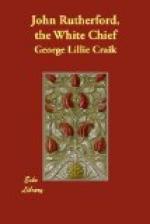Among many nations of the American Indians, indeed, this cutting and marking of the person is one of the principal inflictions to which the aspirant is required to submit on such occasions. Thus, in the account which Rochefort, in his “History of the Antilles,” gives us of the initiation of a warrior among the people of those islands, it is stated that the father of the young man, after a very rude flagellation of his son, used to proceed to scarify (as he expresses it) his whole body with a tooth of the animal called the “acouti”; and then, in order to heal the gashes thus made, he rubbed into them an infusion of pimento, which occasioned an agonizing pain to the poor patient; but it was indispensable that he should endure the whole, adds our author, without the least contortion of countenance or any other evidence of suffering.
Wherever, indeed, the spirit of war has entered largely into the institutions of a people, as it has almost always done among savage and imperfectly civilized nations, we find traces of similar observances. Something of the same object which has just been attributed to the tattooing of the New Zealanders, and the more complicated ceremonies of initiation practised among the American Indians, may be recognised even in certain of the rites of European chivalry, whether we take them as described in the learned volumes of Du Cange, or in the more amusing recitals of Cervantes.
The New Zealanders, like many other savages, are also in the habit of anointing themselves with a mixture of grease and red ochre. This sort of rouge is very much used by the women, and “being generally,” says Cook, “fresh and wet upon their cheeks and foreheads, was easily transferred to the noses of those who thought fit to salute them; and that they were not wholly averse to such familiarity, the noses of several of our men strongly testified.” “The faces of the men,” he adds, “were not so generally painted; yet we saw one, whose whole body, and even his garments, were rubbed over with dry ochre, of which he kept a piece constantly in his hand, and was every minute renewing the decoration in one part or another, where he supposed it was become deficient.”
It has been conjectured that this painting of the body, among its other uses, might also be intended, in some cases, as a protection against the weather, or, in other words, to serve the same purpose as clothing. Even where there is no plastering, the tattooing may be found to indurate the skin, and to render it less sensible to cold. This notion, perhaps, derives some confirmation from the appearance which these marks often assume.
Cook describes some of the New Zealanders, whom he saw on his first visit to the country, as having their thighs stained entirely black, with the exception of a few narrow lines, “so that at first sight,” says he, “they appeared to wear striped breeches.”




